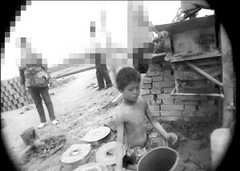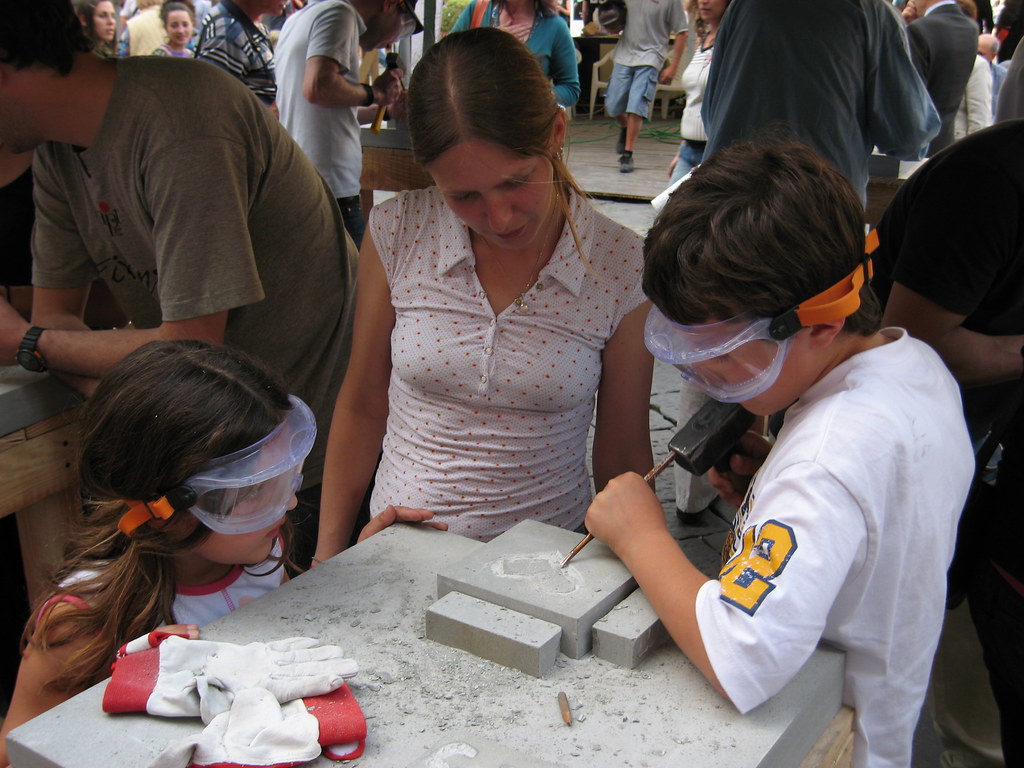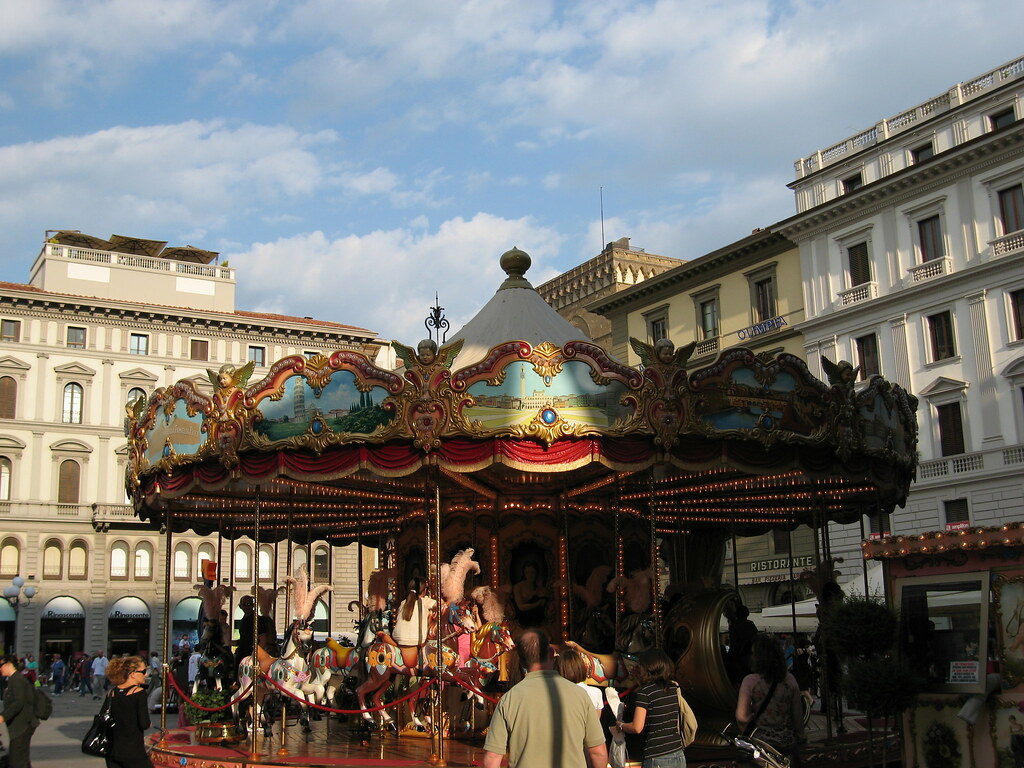今日雨果
[email protected] 博客名 “今日雨果”纯为召唤维克多·雨果代表的一种崇高精神。我名叫“小雨”。歌剧《砖窑孩子》
Opéra “Les Enfants des Briqueteries”
Opera “Bambini in Borno”
Opera “Children in Kiln”
作者: 今日雨果


(取自,谢谢)
意大利,佛罗伦萨,欧洲文艺复兴发源地,市中心广场上,孩子们正聚精会神地在砖上雕刻爱心。小雨摄于2007年5月
意大利,佛罗伦萨,市中心,位于同一个广场上,供儿童们游玩的旋转木马。小雨摄于2007年5月
歌剧《砖窑孩子》
序曲
第一场
(童声独唱)爸爸啊爸爸,小豆子很想你。
这里的砖太多太沉。
我好想搂着你的腰骑上自行车,
我好想拉着你的手走进小学校。
妈妈啊妈妈,小豆子很想你。
这里的泥太湿太冷。
我好想穿你缝补的旧衣服,
我好想吃你做的热菜热汤。
(男女声二重唱)孩子啊孩子,你在哪里?
你的爸爸妈妈在想你。
不要流泪,不要哭泣,
黑暗就会过去,光明就要来临。
(童声独唱)星星啊星星,请你不停地眨眼睛,
为小豆子指引方向。
月亮啊月亮,请你快快钻出云朵,
为小豆子点一盏明灯。
(男女声二重唱)孩子啊孩子,你在哪里?
你的爸爸妈妈在找你。
不要难过,不要伤心,
冬天已经过去,春天已经来临。
小鸟啊小鸟,请你快快醒来歌唱,
教育我们的孩子鼓起勇气。
太阳啊太阳,请你快快升起,
为我们的孩子带去温暖和光明。
(合唱)孩子啊孩子,我们看见了你,
你的亲人们会帮你。
擦去眼泪,看清世界,
把妖魔赶下地狱,把鬼怪押上法庭。
孩子啊孩子,我们看见了你,
全世界的叔叔阿姨们会关心你。
抬起头,挺起胸,
你一定是个好孩子,你一定会成个好艺术家。
第二场
在一群神秘的好心人的帮助下,小豆子与父母重逢。。。
(童声独唱,男女声二重唱,童声及男女声三重唱)
。。。
在一群神秘的好心人的帮助下,小豆子回到了学校。每天唱着歌去上学。
“杏花村里来了一群小鸭子”
(童声独唱,男女童声二重唱,童声合唱,少年芭蕾伴舞)
杏花村里养了一群小鸭子
我天天早晨赶着它们到池塘里
小鸭子向着我嘎嘎嘎地叫
再见吧,小鸭子
我要上学了
再见吧,小鸭子
我要上学了
杏花村里养了一群小鸭子
我放学回来赶着它们到棚里去
小鸭子向着我嘎嘎嘎地叫
睡觉吧,小鸭子
太阳下山了
睡觉吧,小鸭子
太阳下山了
在美术老师的精心培育下,小豆子(肖青松)爱上了泥塑艺术。。。
(童声独唱,童声合唱)
第三场
1989年,天安门,民主运动,肖青松雕塑《民主女神》,而遭追捕。。。
在一群神秘的好心人的帮助下,他乘小船背井离乡,飞奔自由。。。(可引鉴罗西尼歌剧《Tancredi》 "Di tanti palpiti"中乘船的情景及八位歌唱家对该咏叹调不同的演唱风格[5])
肖青松出国后,观看到《巴赫-为自由而战》[6]这部影片,触景生情,禁不住泪如雨下。他为那位梦想成为石雕匠的小男孩遇到了巴赫良师的幸运而感到羡慕,他为自己那恶梦般不堪回首的遭遇而感到悲伤,他在思想上有了质的飞跃。。。(男高音大段咏叹调独唱)
“在激情中生活!”从此,他更迷上了雕塑艺术。。。
(合唱)
。。。
第四场
肖青松艰苦求索,访问、研究了世界各国多姿多彩的雕塑艺术。。。(此处,可引鉴小约翰·施特劳斯的歌剧《蝙蝠(Die Fledermaus )》中如何穿插舞蹈场面,从而以各国舞蹈、芭蕾,展现多姿多彩的雕塑艺术)
肖青松在创作过程中,遇到了知音,爱上了一位女芭蕾演员。。。(此处,可引鉴小约翰·施特劳斯的歌剧《蝙蝠(Die Fledermaus )》中,帕瓦洛帝演唱的牧羊人对恋人的思念之歌,以及帕瓦洛帝与琼·萨瑟兰的深情二重唱[7])
他激发出无穷无尽的创作灵感,作品层出不穷,成了一名二十一世纪出色的雕塑家。
。。。
第五场
盛名之下,肖青松仍念念不忘当年助他脱离苦海的好心人,到处去找她(他)们。。。
(男高音独唱,男女声二重唱,男女多声部重唱,大合唱)
。。。
后记
Post-scriptum
Poscritto
Postscript
同样是发生在2007年5月,同样是一个地球上的少年儿童,同样是面对着一块块砖,他们的境遇竟是如此的天壤之别。
说真的,实在不忍心把这两组照片放在一起,唉。。。
上方两张照片[1][2]:发生在2007年5月,中央电视台《时空连线》报道,山西黑砖窑里的孩子。孩子反应迟钝,常常语无伦次。但被记者问及砖窑时,孩子嘴里蹦出了“监狱”的字眼。
下方两张照片:也是发生在2007年5月,意大利佛罗伦萨[3](位于意大利中部,14世纪~16世纪欧洲“文艺复兴”[4] 的发源地。有一说是,徐志摩把它译成“翡冷翠”,更富有诗意)。小雨随意逛到该市中心的一个广场上,远远地就听到欢声笑语不断,走近才知是当地某组织在向少年儿童免费传授“文艺复兴”时期的雕刻技术。照片前景上的孩子正聚精会神地在砖上雕刻一颗爱心,您可看到左侧和后方的孩子们也在雕刻,旁边还有雕刻师专门指导。一共有五六个雕刻工作台,其他台上雕刻的形象更复杂,记得有一个形象是儿童的头像。
小雨人在天涯,天隔一方,全然不知山西黑砖窑童工之苦,深深叹惜当时只拍了这一张。。。
参考文献
Référence
Riferimento
Reference
[1]
山西黑砖窑379人获救童工自述犹如监狱服刑
http://www.syd.com.cn/2007-06/15/content_24044605.htm
[2]
往事不堪回首:大学生讲述沦为黑窑奴工的亲身经历
文章来源: 潇湘晨报于 2007-06-19
http://news.wenxuecity.com/BBSView.php?SubID=news&MsgID=419222
[3]
佛罗伦萨
维基百科,自由的百科全书
http://zh.wikipedia.org/wiki/佛罗伦萨
[4]
文艺复兴
维基百科,自由的百科全书
http://zh.wikipedia.org/wiki/文艺复兴
[5]
Gioachino Rossini - Tancredi - "Di tanti palpiti" (Marilyn Horne, Lucia Valentini-Terrani & Agnes Baltsa)
http://www.youtube.com/watch?v=7KWS7Zd8GJ4
Gioachino Rossini - Tancredi - "Di tanti palpiti" (Ewa Podles, Vesselina Kasarova & Jennifer Larmore)
http://www.youtube.com/watch?v=42zVcZEbsjI
Gioachino Rossini - Tancredi - "Di tanti palpiti" (Cecilia Bartoli & Vesselina Kasarova) - Appendix
http://www.youtube.com/watch?v=Q9P6VI46I_o
Not one compilation of Rossini's musical output would be complete without his first "hit tune": "Di tanti palpiti", the moderato section (a cabaletta of sorts) from the cavatina of Tancredi. In his biography of the Maestro, Stendhal wrote that the aria of Tancredi, known throughout Europe, was the most popular opera aria of its time... And also refered to as the "rice aria" because Rossini is supposed to have composed it while waiting for his risotto to cook one day in Venice (imagine: a hungry composer composing such a little masterpiece out of boredom :) )!
The cavatina deals with Tancredi's return from exile Tancredi to defend his homeland against the Saracene besiegers (and to see Amenaide, of course).
Although many recordings of the aria usually give us only the moderato, Tancredi's cavatina is actually a whole scene: an interlude (depicting Tancredi's boat dropping anchor in a port) - an impassioned recitative - a short (and rather boring) aria - a "cabaletta". It's also interesting to point out that the aria is quite "unrossinian" in character, it almost seems to come from another musical period: the moderato section could be attributed to any composer from the end of the 18th century.
I decided to post only the "Di tanti palpiti" section for a number of reasons, chief amongst them being the fact that it is really the best part of Tancredi's cavatina. It's almost a suprise when it appears after the rather uninspired cantabile.
I once had about ten versions of this aria (including two renditions sung by sopranists, Kowalsi and Manzotti) but I narrowed the choice to six versions:
1) Marilyn Horne (I presume that it's from her full recording of the score). A real classic, Horne just continues to pour out beautiful sound during the whole piece. I also the use of moderate ornamentation during the repeat which doesn't destroy the musical balance and the slow, relaxed tempo from the orchestra.
2) Lucia Valentini-Terrani (from her disk "Arie di Rossini" with Zedda). A good rendition but I find the voice a bit too light for the role. The additional coloratura is well integrated but a bit over the top in places (listen to the very beginning of the repeat, it's a bit too extroverted for a warrior returning to an "ungrateful homeland").
3) Agnes Baltsa (from "Agnes Baltsa sings Rossini" with Marin). Baltsa really "gets" the situation and offers some relaxed singing though I don't like the intrusive mannerisms (there some unattractive glottal attacks). Marin seems to want to mute out the singer with a very loud orchestra.
4) Ewa Podles (from the complete recording with Zedda). I personally love the relaxed conducting here: no rushing. I also think that Podles comes close to Horne's standard. An excellent account.
5) Vesselina Kasarova (from the complete recording with Abbado). Again, as in the selections of the second act duet for the lovers, I find that Kasarova is somehow over the top: she paints almost every word and adds quite a lot of ornamentation, even to the first verse (though, most of it is tasteful; the problem is in quantity, rather than quality). She is good but quite overwhelming.
6) Jennifer Larmore (from her excellent album "Call me Mister"). I really do like Larmore, and she doesn't disappoint here: she really sounds like a warrior (compare with Valentini-Terrani who sounds rather tame by comparison). Ornamentation is good, even if it is familiar (though after listening to six versions of the same aria it is bound to be).
The renditions are grouped into two uploads (just check the title to find the one you would like to hear :)).
I also decided that a little appendix wouldn't hurt, so I am also uploading two replacement arias for "Di tanti palpiti":
7) Cecilia Bartoli (from her hit album "Maria"). The piece presented is actually Giovanni Pacini's own composition, "Dopo tante e tante pene" composed for "Tancredi" to show off Maria Malibran's wide vocal range. It's actually not bad, the cabaletta is even quite fun to listen too but it would seem out of place in Rossini's opera (to my mind it is too romantic for Rossini's more classically composed opera).
8) Vesselina Kasarova (again, from the full recording under Abbado). This aria is very similar to the replacement aria for Lindoro in "L'italiana in Algeri" ("Concedi, amor pietoso"), especially the cabaletta. It is quite good as a replacement because it features a much better cantabile section (a way better one, in fact) and the cabaletta is as passionate as in the original.
Hope you enjoy :)! Do take your time and listen to all selections, it's quite interesting to compare them (though, again, this isn't a contest, rather a comparison).
P.S. If you'd rather hear a countertenor sing the aria, then check David Daniel's excellent account on Youtube :).
[6]
★ 巴赫牧羊随想曲 2007-10-19 23:10:27
作者:今日雨果
这几天在观看 DVD《巴赫 - 为自由而战》(德语《Bach - Kampf für die Freiheit》法语《Bach - Lutte pour la Liberté》意大利语《 Bach - Lotta per la Libertà》英语《Bach – Fight for Freedom》)的DVD(1995)。影片中,均以巴赫作的乐曲为背景音乐,石雕匠的凿石节奏,家庭聚会的欢乐笑声,。。。凡人世间的一切美好景象,都成了他创作的源泉。
影片主要讲的是巴赫与一位梦想成为石雕匠的小男孩之间的故事。其中,巴赫找到了一个激动人心的担任音乐大师的职位,因循守旧的公爵不准他离去。巴赫义正词严地对他说:“我是我自己的主人,你无权将我困在这儿!”公爵将他囚禁在监狱里,他继续作曲不已。
在影片中,巴赫对小男孩说:“从不绝望!我知道当无人相信你的时候的感觉是什么滋味。你只是要坚持不懈地相信你自己,你要知道你的内心深处是如何的独特,。。。人类的精神是那么一种不可思议的力量,。。。尽管有人千方百计要使你感到绝望,我们的精神依旧可以高扬在天上翱翔。。。在激情中生活!”
写到此处,小雨突然想起了一件事。您一定还记得2007年6月有关“山西黑砖窑孩子”的报道吧。有朝一日,如果您见到了这些砖窑孩子,请一定让他们观看《巴赫 - 为自由而战》这部影片,小雨相信他们一定会以巴赫为良师,以那位梦想成为石雕匠的小男孩为榜样,从此在激情中成长,在激情中生活。与此同时,歌剧“砖窑孩子”的剧情也就有了新的发展。
http://blog.wenxuecity.com/blogview.php?date=200710&postID=27865
[7]
Luciano Pavarotti and Marilyn Horne as guests of Joan Sutherland in the operetta: The Bat/ Part 1
http://www.youtube.com/watch?v=ciVuD1pWZW8
Luciano Pavarotti and Marilyn Horne as guests of Joan Sutherland in the operetta: The Bat/ Part 2
http://www.youtube.com/watch?v=Y1xDgoce2Eg
原稿 : 2007年6月17日:小诗
二稿 : 2007年6月18日
三稿 : 2007年6月20日:改为唱诗
四稿 : 2007年7月15日:改为歌剧
五稿 : 2007年10月20日:观看 DVD《巴赫 – 为自由而战》后,有感而发,修改剧情。
六稿:2010年12月24日:圣诞夜,再次观看 DVD《巴赫 – 为自由而战》后,有感而发,剧情由三场增为五场。
七稿:2012年4月1日: 吸收素材:实拍:山西农村儿童简陋窑洞中艰辛求学(组图)
最新稿:始终登载于小雨的博客上:http://blog.wenxuecity.com/myindex/13005/
声明:转载请务必注明作者及出处。若无注明,所有照片及视频均为作者所摄。作者保留文字,照片及视频的版权。
联系:[email protected]




